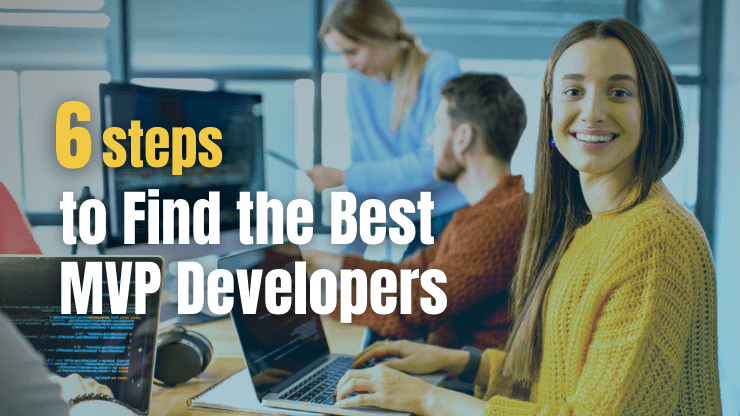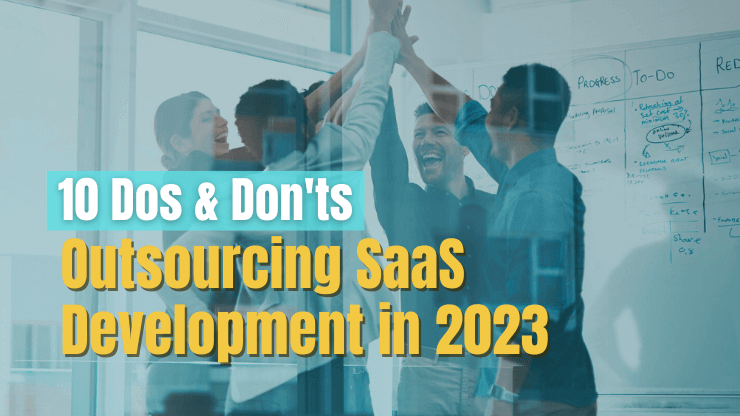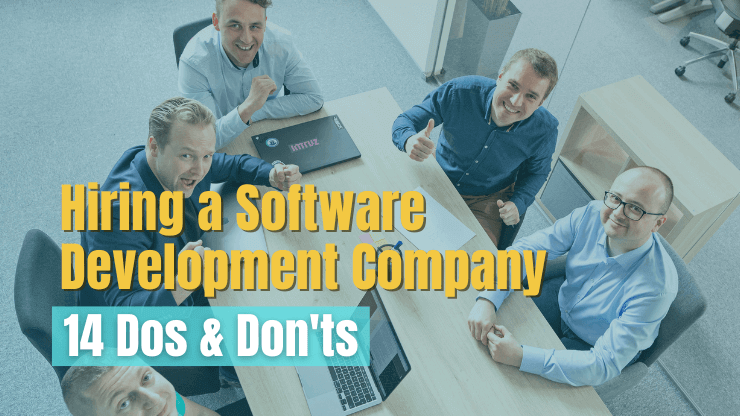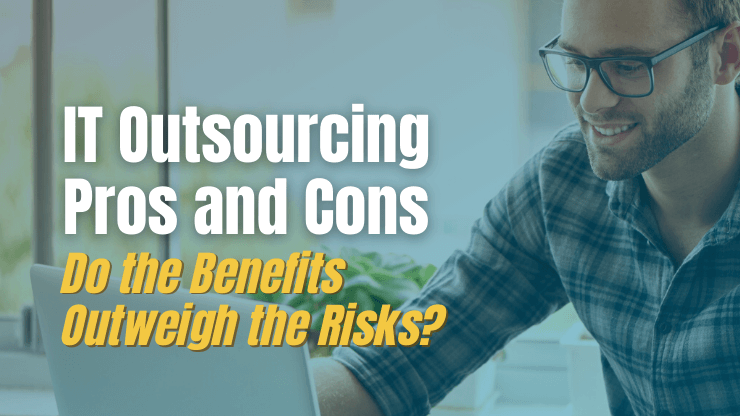Today, many startups go to market with what’s called a minimum viable product (MVP) - a version of the final product that has the minimum features to make it usable by real customers. This is a great way to test the waters with a new idea without spending years in development.
In fact, on average, MVP software development takes 4 months, but the costs are far less predictable. Hiring the right MVP team can help you both expedite delivery of your MVP and keep your budget down.
We’re going to walk you through 6 steps to find the best MVP developers to help launch your startup idea. Let’s get started!
What is MVP software development?
MVP development is simply the development of a minimum viable product (MVP).
A minimum viable product (MVP) is a product with just enough features to be usable by real end-users. Typically a minimum viable product builds on the development work done during prototyping.
The idea is to build a version of the product with all of the basic functionality, release it into the market and use real customer feedback to inform later versions of the product.
Utilizing a minimum viable product is one way of embracing validated learning in the development process. As you learn more about what the early adopters like and don't like, what works and what doesn’t, you can adjust your product to better align to the market. Essentially, an MVP is one way to test business hypotheses directly in the market. This explains why there is such a huge demand for startup MVP development.
MVP vs Proof of Concept vs Prototype
An MVP is sometimes confused with prototype vs proof of concept. These three things, while in some ways similar, are each distinct phases of the product development lifecycle.
A proof of concept (PoC) is built very early in the product life cycle, often before any investment is raised, a full team is formed, or a formal business idea is established. It is used to prove if a project is feasible or not and if it’s worth further investment. This validation stage is critical as it can help to justify costly design and development work that comes later.
A prototype is typically where your product becomes tangible for the first time. It’s meant to give teams an idea of what they are going to build - a way to visualize things for the first time. The level of detail of a prototype can vary significantly.
The lowest budget option would be to sketch out a design with pen and paper. More advanced prototypes can be created in tools such as Figma as interactive designs and tested with real users.
Benefits of minimum viable product development
So what’s the purpose of MVP development? Why would you spend your budget on MVP development services? In short, it allows you to more quickly enter the market, get real user feedback, and improve your product iteratively.
The alternative to MVP development is typically investing in more software development cycles and releasing the product into the market later. While many companies still use this business model, an MVP is a great option to help you time the market better, draw up some initial demand (and revenue), and take cues for future development from the product’s initial users.
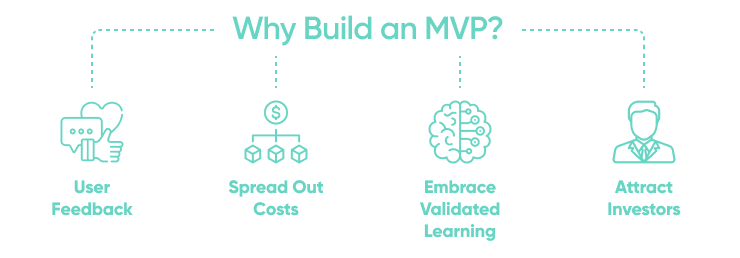
There are several key benefits to MVP development:
- Get useful feedback on the product’s basic features.
- Avoid having to fund the complete product upfront.
- Embrace validated learning as part of the product development.
- Attract late-stage investors who prefer to see a shipping product instead of just business ideas.
Your custom MVP development project might not reap all of these benefits, but even a few can help to reduce overall product development costs and get you to market faster. For this reason, MVP development is a no-brainer for most startups. But, how do you find the right MVP developer for the job? Let’s take a look.
How to find the best developers for MVP (6 steps)
Hiring the right MVP development company is critical. For most startups, the team you work with on your MVP will also be a long-term partner for all future development.
While it might be tempting to start googling around for an MVP app development company as soon as you greenlight your project, it’s important to be patient and work through these 6 steps to ensure you’re making the right choice.
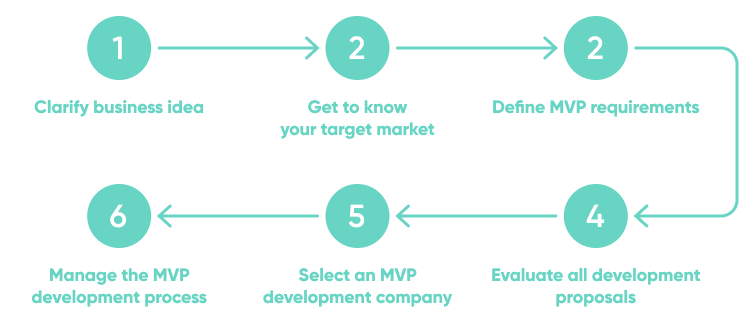
Clarify business idea
Before you tackle hiring an MVP developer, you need to be really clear on what you’re trying to build. Many entrepreneurs have an idea and move quickly into the staffing-up phase. While development teams can help you clarify your vision, it’ll be a lot more cost effective to be really clear on what you want before you contact developers.
And, in this stage we’re not even talking about detailing out specifics about your MVP. In this very first step you need to clarify your business or product idea. You can ask questions such as:
- What are you going to market with?
- What should your final product look like?
- What does your market research tell you about your target market?
- Do you understand your end user and what their needs are?
No matter how many skilled developers you hire, if you aren’t building the right thing, your product won’t last in a competitive market.
Define MVP requirements
You’re really clear on your business idea and product concept, now you’re ready to start defining your MVP requirements. When developing an MVP, you’re building a version of your end product - the minimum viable version of that end product. So during this stage it’s really critical to gain clarity on what will and will not be included in this version of the product. You’ll do this by first writing out all possible requirements, then we’ll score them.
Requirements typically break down into two categories: technical and functional. Anything you expect your users to be able to do or anything you expect your software to do should be defined as requirements. Assume nothing.
Example technical requirements:
- The software will have an average page load time of less than 2.2 seconds.
- The software will be down less than 1% of the time.
- The software will integrate into the existing technology stack.
Example functional requirements:
- Admins should be able to create new accounts manually.
- Users should be able to change the frequency of when reports are generated.
- Users should be able to select light or dark mode.
As you define your requirements, consider involving other stakeholders such as product managers, sales teams, and project managers. Having an array of inputs can be very helpful at this stage.
After you have a full list of possible requirements, it’s time to prioritize them. Remember that your MVP might not have all the features of your end product. It might have a subset of these features, and that is ok. This is where you need to make those calls about project scope and what will be most helpful to include in the MVP for your target audience.

Use your requirements list to mark each item with “priorities.” Many teams opt to use the standard M, S, C, W labels to help organize requirements. This can help you to come up with a final list of requirements that you’ll include in your MVP project. All others you can save for future development.
Identify potential MVP development partners
With all of your requirements and project scope identified, it’s time to start looking for experienced MVP development companies. There are many options available from general software developers to large companies with extensive software product development experience. Ideally you may want to focus on finding an experienced team with a track record how to build a minimum viable product.
Top tips for identifying potential MVP development partners:
- Look for experience: You'll want a partner that has experience delivering MVP development services, specifically. They should understand the lean startup methodology and how to build a product with a minimal feature set.
Look for a development team that understands your vision: It's important that you partner with a team that understands your vision for the product. They should be able to provide input and feedback during development.
Look for a development team that is responsive and communicative: During development, there will be a lot of back-and-forth communication. You'll want to partner with a team that is responsive and communicative, so that you can get your MVP built as quickly as possible.
Get referrals: One of the best ways to find a leading mvp development company is to get referrals from other entrepreneurs who have developed MVPs. Ask them who they used and if they were happy with the results.

After you have a few options identified, reach out and request a development proposal. This will help you further evaluate your options and select one that is the best fit for your project.
Evaluate all development proposals
Now it’s time to evaluate the proposals you’ve received for your short list of MVP development companies. In general, a software development proposal should clearly and concisely contain the following information:
- Understanding of the problem to be solved - Look for how well the MVP development company understands the problem at hand.
- How they propose to achieve the solution - Look for specificity. A well-thought out proposal will provide at least some detail on the exact development services they will provide.
- Team members they would involve in the project - Evaluate how well their technical backgrounds align to the project at hand.
- Schedule - Look for how well this aligns with your expectations and deadlines.
- Budget - Look for how well this aligns with your expectations and internal budget for the project.
During this evaluation stage, consider how you would feel about a long-term partnership with the development partners. If you’re new to hiring out software development or don’t have a formal sourcing team on your side, it might be helpful to learn more about how to start a successful software development partnership.
Select an MVP development company
Weighing your options from the previous step, you should select an MVP development company that best fits your requirements. Make sure to survey all stakeholders before making a decision. After you decide on an MVP software development company, you need to negotiate and sign a contract.
When negotiating a contract with a software company, it is important to consider the terms of the agreement, the length of the contract, the price, and the delivery schedule.

The next step is to have a meeting with the software company to discuss the contract. During the meeting, it is important to be clear about your expectations and to ask questions about the company's products and services. Make sure you thoroughly understand the terms of the agreement. This is your chance to negotiate any changes you’d like made.
Finally, you will need to sign the software development contract. Once the contract is signed, you should make sure to keep a copy for your records.
Now you’re ready for kickoff!
Manage the MVP development process
The key to successfully developing an MVP is effective project management of the development process. Here are some tips on how to manage the development process:
- Hire a project manager. Whether on your team or on the development team, you should have at least one project manager to help with all aspects of project planning and implementation.
- Track progress. Use project management tools to track project development. This will help you identify any bottlenecks or issues that need to be addressed.
- Be crystal clear on the timeline. When do you want the MVP to be completed? Work backwards from that date to create milestones and deadlines for the project.
Cost to hire MVP developers
The cost of hiring developers for your MVP typically depends on three major factors:
- Developers' experience
- Size and scope of the project
- Location of the developers
Generally speaking, developers with a few years of experience can cost anywhere from $50-$100 per hour. More experienced developers can cost $100-$200 per hour or more.
The size and scope of the project is another important factor to consider when budgeting for MVP development. A small, simple MVP might only take a few weeks to develop and can cost a few thousand dollars. A larger, more complex MVP can take several months to develop and can cost tens of thousands of dollars.
Finally, the location of the developers can also affect the cost. Developers in North America and Western Europe tend to be more expensive than developers in other parts of the world such as outsourcing to Eastern Europe. This is due to a number of factors, including the cost of living in these regions and the availability of experienced developers.
Overall, the cost of hiring developers for your MVP can vary depending on a number of factors, see hiring developers for startup. You should consider what your priorities are to ensure the development team you select aligns with not just your budget but also your expectations for your end product.
Conclusion
Finding the right MVP developers for your startup can be tricky. There are so many options in the market that you might simply feel overwhelmed with choice, but if you stick to the 6-step strategy we discussed, you can be confident that you’ve adequately vetted your startup idea, thoroughly documented your MVP requirements, and sourced the right team to help you build your software MVP.
If you're looking for help developing a MVP, consider our software development agency. Our team can work with you to put together a comprehensive plan and guide you through the development process - reach out for a free quote.

